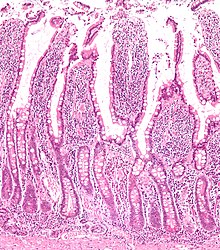Lieberkühn crypts
Lieberkühn crypts (Latin: glandulae intestinales ), also known as Lieberkühn glands and cryptae intestinales , are about 0.2 to 0.4 mm deep, tubular, partially branched depressions in the epithelium in the area of the mucous membrane of the small and large intestine. They were named after the Berlin doctor and anatomist Johann Nathanael Lieberkühn (1711–1756).
The Lieberkühn crypts are used for surface enlargement and secretion as well as, according to more recent findings, the control of the iron balance in the human body through regulatory proteins. They were discovered in 1688 by Marcello Malpighi , but Lieberkühn was the first to describe them in 1745 in his “Dissertatio de fabrica et actione villorum intestinorum tenuium hominis”.

The intestinal villi with the Lieberkühn crypts are shown as a histological specimen of the small intestine mucosa .
literature
- M. Malpighi: De structura glandularum conglobatarum consimiliumque partium epistolae , London, 1689; Leyden, 1690.
- JK Brunner: Glandula duodeni, seu pancreas secundarium detectum , Frankfurt / Heidelberg, 1715.
- JN Lieberkühn: Dissertatio de fabrica et actione villorum intestinorum tenuium hominis , Leiden, C. & GJ Wishof, 1745.